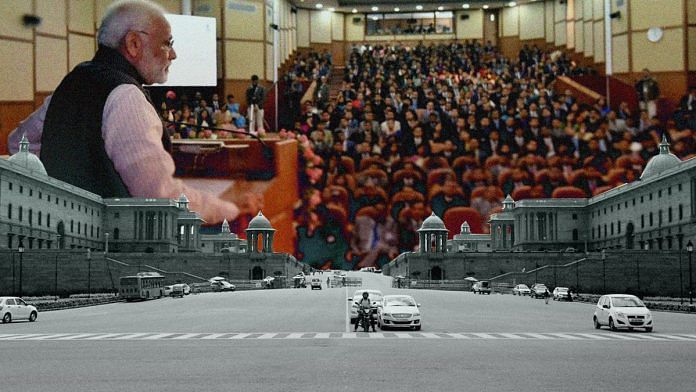Prime Minister Narendra Modi’s government has decided to expand its plan of recruiting people from outside the civil services into the ranks of joint secretary, deputy secretary and director. The move is aimed at boosting efficiency and bringing additional expertise into government departments.
ThePrint asks: Influx of lateral entrants: Is it reform of bureaucracy by Modi or dilution of IAS grip?
A brilliant idea but manner in which Modi govt is implementing lateral entry is fraught with issues
 T.R. Raghunandan
T.R. Raghunandan
Former IAS officer and advisor to ‘Accountability initiative’, Centre for Policy Research
The principle of lateral entry is excellent and makes for an ingenious idea. The IAS, as it stands today, has plenty of problems and tends to become moribund over a period of time. Certain ministries that are considered “glamorous” are always the most coveted. In my experience, social sector ministries like the Panchayati Raj, where I worked, are critical to the development of India. But many senior IAS officers don’t want to serve in these ministries. Moreover, there is a great deal of stagnation in the service – by the time an officer is promoted, they are left with just a few months to serve as secretary.
I served under five secretaries in my tenure, and I have respect for only two of them. I was closer to field realities than many of my bosses, who lacked knowledge on many subjects.
While the idea of lateral entry is brilliant, the manner in which the government is implementing it is fraught with issues. There is no transparency, and out of nine lateral entrants recently inducted, there doesn’t seem to be a single South Indian, ST or OBC person. They all seem to belong to a particular ideology and there is certainly a likelihood of political infringement on decision making. It’s akin to filling the services with their own comrades in arms.
The bureaucracy shouldn’t be made vulnerable to any particular ideology — either of the Left or the Right. I don’t mind implementation of lateral entry but the way this govt is going about it, raises serious questions about transparency.
You don’t need to be a cheerleader of Modi govt to applaud the right kind of reform
 Nitin Pai
Nitin Pai
Director, Takshashila Institution
Public administration, to paraphrase Georges Clemenceau, is too serious a matter to leave to the All-India Services alone. The Modi government has done well to initiate administrative reform by opening the doors of government to talented people from outside the civil services.
It is absolutely necessary to get talent, expertise and experience into the government. This means two things: get people from the private and non-government sector into the administration, and, as importantly, upgrade civil servants across the board with cutting-edge skills. Lateral entry helps achieve the former. Massive investment in training civil servants is also necessary.
I have addressed the substantive concerns about lateral entry in a previous TalkPoint. Let me address a different objection: that the Modi government will fill the ranks of the civil services with its ideological supporters. Even if that were to happen, how would it be any different from the current system where it is not uncommon to see civil servants doing what the politician wants, rather than observe constitutional propriety? If corruption and corporate capture is a concern, then how is it any different than the status quo?
You don’t need to be a cheerleader of the Modi government to applaud the right kind of reform when you see it. Of course, we can disagree whether a particular candidate is suitable for a job, without disputing the merits of lateral entry.
It must be said that civil servants, especially from the state public services, need better training, exposure and performance incentives. While elite civil servants get to go to Harvard, those lower down the pyramid get perfunctory training and career development opportunities. This too must change.
The forces of the status quo are strong, vicious and vengeful. We should hope PM Modi prevails over them.
Also read: Proposal to treat each IAS application as attempt: Practical move or unfair to aspirants?
World over, lateral entry is practiced in order to make the bureaucracy more efficient
 Sudhanshu Mittal
Sudhanshu Mittal
Spokesperson, BJP
The Modi government’s move of introducing lateral entry is a step in the right direction to enrich and create more competence in the bureaucracy.
The bureaucracy, in the last 70 years, has not delivered as much and honestly, a lot more is expected from the bureaucracy in a country like India. There have always been certain changes required in the system and to bring about those changes, status quo needs to be challenged. New experiments have to be done. Lateral entry is a perfect example of this experiment.
If one takes a look at the people who are selected for lateral entry, one would realise they are all people of high calibre, who don’t lack merit and have an ideological stance. World over, lateral entry is practiced in order to make the bureaucracy more efficient and increase talent levels. The American and British governments have, too, adopted this method. They bring in talent from outside the government to assist in public duties.
I believe people should act responsibly and not politicise any reform that is beneficial for the country.
We must not negate the contribution IAS officers bring with their generalist approach
 Aruna Sharma
Aruna Sharma
Retd IAS officer
It is still early to pass any judgement on the idea of lateral entry because only nine people have been recruited in the civil services. We must wait and watch out for their performance. In the past, individuals coming through lateral entry were experience officials who had worked in their respective sectors for long — but now I believe mid-career individuals are also being inducted.
Regardless, I think it is very important that the IAS cadre is appreciated and their contribution acknowledged at all times. In the civil services, being a generalist is of utmost importance and many a times, crucial moments require a generalist’s point of view. We must not negate or dismiss the sheer contribution of IAS officers.
Moreover, the IAS grip or control is an inaccurate terminology. IAS officers tend to be the most docile as far as their rights are concerned. One will never see them organise or protest about anything.
Ultimately, it is knowledge that rules. Just having a domain expert will not always help because it might not allow one to have a holistic point of view — sometimes an efficient IAS officer is able to have the foresight.
No one else but IAS officers and their lack of interest are to blame for lateral entries
 Sanjay Dixit
Sanjay Dixit
Additional chief secretary, Rajasthan
The IAS officers may be bothered about the lateral induction at the level of deputy secretaries and directors; they have however nobody else but themselves to blame.
The IAS officers must ask themselves if they are really interested in taking up these positions, which run parallel to their field postings but generate less interest in comparison. And that is why one hardly finds willing IAS officers ready to take up these assignments.
It is only after they have got their Super Time scales that they put in their options for a central deputation at the level of director, hoping to be elevated to joint secretary in a year or two. It is only officers from central services Group ‘A’ and northeast states that are willing to come to Delhi, an odd exception or two notwithstanding.
In 1999, the Rajasthan chief secretary was so alarmed by the state’s inability to fill its deputation quota in the Union government that he forced an entire batch to opt for deputation to Delhi at the level of director.
Such being the reality, I do not think there is any case for either alarm or protest.
Also read: Unethical for IAS officers to join politics ahead of polls or do they make for good netas?
Bureaucratic reform needs to inspire confidence, and not suspicion in the minds of Indians
 Sanya Dhingra
Sanya Dhingra
Principal correspondent, ThePrint
From trying to change the way in which IAS, IPS, IFS officers are recruited to infusing the system with “domain experts” laterally, the Modi government is overhauling the character of India’s bureaucracy. While there is consensus – even among the most conservative and inflexible of bureaucrats – that the system needs reform, the proposed reforms come with their own set of very serious questions.
What will preclude the government from bringing ideologically and politically biased individuals into the bureaucratic fold? What about reservations for individuals from marginalised communities – who may never have had the opportunity to become domain experts? What about the coordination needed between the Centre and states, which continue to be manned by civil servants?
The Indian bureaucracy has its set of problems. But it has survived for decades despite the most vicious forms of political pressure. Every now and then, we encounter upright officers who stand up to political might and do what is constitutionally expected of them. This space must not shrink. Bureaucratic reform, important as it may be, needs to inspire confidence, and not suspicion in the minds of Indians. For that, lateral entry must be expanded in a phased-out, transparent manner after there is some evidence of it being better than the existing system.
By Fatima Khan, journalist at ThePrint.




In my opinion civil servant are the people who they have spend years in preparation to clear India’s toughest exam. So if lateral entry is done then there should be exam/test and it should be transparent.
Mr Raghunandan’s lament about there being none among the recent lateral entries from South India, ST etc. is more of a concern to him that none from Tamil Nadu is there.
This is an excellent idea. But I’m worried about the way it has been thought of. The induction of technocrats, academicians, scientists and domain experts in the administrative system has always been considered as good idea. But let’s choose a rational path. Let’s plan in such a way so that they are rightly identified, admitted in a specially designed learning program for a period of two years, then get evaluated and finally enter into the job at par with the civil services. The evaluation or test should be recognised as equivalent test to the UPSC test for IASs.
The IAS occupies too much space in the government system. It extends beyond retirement, to staffing regulatory bodies as well. Other services need to be accommodated to a larger extent. In terms of caliber, what separates them from the premier service is just a few marks in a common exam, a third of a century before retirement. Along the way, they acquire both experience and expertise that is more sharply focused than someone moving from Animal Husbandry to Atomic Energy. 2. Somehow one gets the feeling that all this talk of lateral entry – assuming it is not meant to pack the system with ideological fellow travellers – is just meant to create a frisson of excitement, like hiring a Michelin starred chef for a restaurant that has been serving up decent Daal Raisina and butter naan all these years.